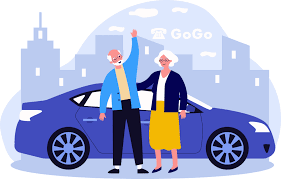This summer Uber, the ridehail company, will pay 175 people in seven U.S. and Canadian cities $1,000 to ditch their cars for a month and use alternate transportation. They call it “One Less Car.” A lot of people may sign up, but chances are they will not be ages 60 and above.
There is a genuine disconnect between older people and the ridehail companies like Uber and Lyft. Both parties have reasons to be suspicious of each other yet both parties desperately need each other. This was eloquently described a few years back when a New York Times writer asked “older people need rides…why aren’t they using Uber and Lyft?“
Most likely older people, as well as handicapped riders, are populations that are more challenging to serve as they bring along regulatory issues. Cities like Boston, Los Angeles, and others require Uber and Lyft to provide wheelchair accessible vehicles (WAV) . It turns out that these vehicles and drivers for them are scarce. Similarly, ridehail companies have to accommodate seeing eye dogs, which some drivers consistently refuse to allow in their cars. Adding to this list are habits that riders bring. They may be clumsy using the app, tip less, and be less familiar with the unusual one to five post-trip rating scale.
There’s Demand:
Yet the market to offer rides for older people only grows. When people retire from work they cut back on their driving. And, as they age, they also reduce trip taking because of reduced vision or other infirmities. Some prefer to not drive at night. And since the average cost of maintaining a car reaches $1,000 a month, those on fixed incomes find that owning a vehicle is a stretch.
During the pandemic there was a large ridership drop but particularly among seniors. They did not want to risk being in an enclosed space with a “stranger.” Since Covid, ridership has rebounded, but less so by seniors. They are still fearful, for other reasons.
It’s fair to say, as the New York Times writer wrote a few years back, that seniors do not favor Uber and Lyft. What might be the reasons? In my experience as a classroom teacher, here are some of their concerns:
Making Mistakes:
The most obvious one is that seniors are not as comfortable as younger people with their smartphones; perhaps multiple cars will come instead of just one or they will not recognize the driver. They are afraid they will make a mistake and rack up credit card charges. They lean towards old-fashioned taxi service because there is a human voice at the other end of the transaction.
Second, they have a fear of getting lost- lost in the geographical sense that they will not accurately specify where to be picked up, or where they are going. Almost every ridehail user makes an origin/destination mistake now and then, but younger people are more secure about reversing the error.
Making & Overcoming Fear:
Third, and this issue is truly intangible: some seniors still harbor a fear that drivers might take advantage of them. It’s not clear why they perceive that ridehail drivers are less trustworthy than other chauffeured services. Perhaps the negative view got planted in the early years of ridehail (2012-2015)when there was a spate of negative coverage about rogue drivers and uninsured cars.
Finally, before the pandemic Uber and Lyft sponsored a few programs to help apprehensive riders overcome their doubt. They supported senior centers with coupons for new-riders, written guides, and occasionally, by sending a travel ambassador. Today, would-be riders are on their own as they learn to use the ridehail apps. Sometimes senior centers and transportation agencies step in to fill the gap or businesses, like GoGoGrandparent, find a niche.
Growing Numbers:
Increasingly, older people are getting accustomed to using their phones for everyday activities and shopping but there are still holdbacks when it comes to ridehail travel. There’s irony to this since in 2019, per Statista, more than 32 percent of Uber and Lyft drivers were ages 61 to 70. Ten percent of the drivers were age 71 or older. And, when it comes to numbers, by 2030, all of the Baby Boomers will be 65 or older and the U.S. census projects that older people will outnumber the number children under age 18.
It’s great that there are contests to get people out of their vehicles. But it’s also time to rethink how to get seniors and others with special needs to join in too.

